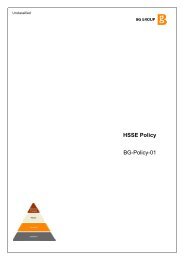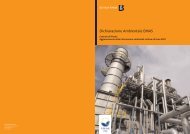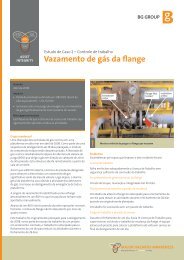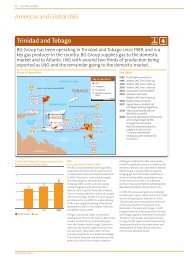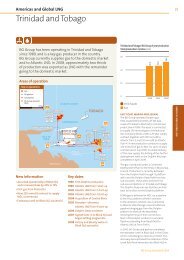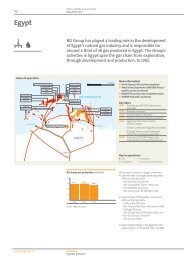HSSE Management Tours - BG Group
HSSE Management Tours - BG Group
HSSE Management Tours - BG Group
Create successful ePaper yourself
Turn your PDF publications into a flip-book with our unique Google optimized e-Paper software.
<strong>HSSE</strong> <strong>Management</strong> <strong>Tours</strong>:<br />
Asset Integrity Guide<br />
Design &<br />
Build Integrity<br />
Identify &<br />
create Barriers<br />
Asset<br />
Integrity<br />
Operate with<br />
Integrity<br />
Working within<br />
the Barriers<br />
Sustain<br />
Integrity<br />
Maintain Barriers<br />
1
<strong>HSSE</strong> <strong>Management</strong> <strong>Tours</strong>:<br />
Asset Integrity Guide<br />
2
Contents<br />
1<br />
2<br />
Introduction<br />
• <strong>HSSE</strong> <strong>Management</strong> <strong>Tours</strong>:<br />
Asset Integrity Guide<br />
• How to Structure Your Asset Integrity<br />
<strong>Management</strong> Tour<br />
• Asset Integrity Overview<br />
Managing Integrity<br />
• Topic 1 - Maintenance of Barriers<br />
• Topic 2 - Integrity Communications<br />
• Topic 3 - Performance <strong>Management</strong><br />
• Topic 4 - Planning and Resourcing<br />
• Topic 5 - Corporate Safety Culture<br />
• Topic 6 - <strong>Management</strong> of Change<br />
• Topic 7 - The Safety Case<br />
3<br />
4<br />
Key Integrity Barriers<br />
• Topic 8 - Operating within the Envelope<br />
• Topic 9 - Pressure Safety Valves<br />
• Topic 10 - Pressure Vessels<br />
• Topic 11 - Piping (incl. small bore piping)<br />
• Topic 12 - Structural Integrity<br />
• Topic 13 - Process Control<br />
• Topic 14 - Alarm <strong>Management</strong><br />
• Topic 15 - Leak and Fire Detection<br />
• Topic 16 - Emergency Shutdown & Blowdown Systems<br />
• Topic 17 - Control of Ignition Sources<br />
• Topic 18 - Fire Protection<br />
• Topic 19 - Escape, Muster and Evacuation<br />
Summary<br />
• <strong>HSSE</strong> <strong>Management</strong> Tour Briefing Cards<br />
1
• Asset integrity (process safety) differs from<br />
occupational safety (personal safety) because it<br />
focuses on the hazards that are more likely to result<br />
in major accidents (gas explosions, jet fires, ship<br />
collisions, etc.) affecting large numbers of personnel<br />
rather than incidents affecting individual workers<br />
(slips, falls, struck-by incidents, electrocution, etc.).<br />
• The management of occupational safety and asset<br />
integrity has both similarities and differences, but<br />
it is important to understand that management<br />
of one does not assure management of the other.<br />
Robust systems need to be in place to manage both,<br />
and the workforce should understand that both are<br />
important to the success of <strong>BG</strong> <strong>Group</strong>.<br />
• This handbook is intended to provide senior<br />
personnel with a basis for discussing asset integrity<br />
topics during a <strong>HSSE</strong> management tour. Historically<br />
<strong>HSSE</strong> <strong>Management</strong> <strong>Tours</strong>:<br />
Asset Integrity Guide<br />
1<br />
Introduction<br />
<strong>HSSE</strong> <strong>Management</strong> <strong>Tours</strong>: Asset Integrity Guide<br />
these tours have been dominated by occupational<br />
safety observations and discussions, and so the<br />
purpose of this handbook is to broaden the scope<br />
so that asset integrity is also discussed during<br />
such visits.<br />
• This handbook should be used in conjunction with<br />
the “<strong>HSSE</strong> <strong>Management</strong> <strong>Tours</strong>: A Guide” handbook,<br />
which contains general guidance for planning and<br />
performing a <strong>HSSE</strong> <strong>Management</strong> Tour.<br />
2
1 Introduction<br />
<strong>HSSE</strong> <strong>Management</strong> <strong>Tours</strong>: Asset Integrity Guide (continued)<br />
• Each topic in this handbook provides a broad<br />
overview of the subject area and suggested initial<br />
engagement questions. The language is deliberately<br />
plain to provide a level of comfort and confidence for<br />
users regardless of their background. The questions<br />
are structured in an open way to provide the basis for<br />
an open discussion with employees.<br />
• Open discussions on asset integrity issues offer the<br />
potential to understand perceived problem areas and<br />
identify opportunities for improvement. An attitude<br />
of openness and honesty is required in discussions<br />
and the desire to listen to, and discuss, an individual’s<br />
issues is critical to avoid any potential filtering or<br />
‘good news only’ responses.<br />
3
1<br />
Introduction<br />
How to Structure Your Asset Integrity<br />
<strong>Management</strong> Tour<br />
• Prior to the tour it will help to familiarise yourself<br />
with the safety case for the facility. This will provide<br />
a good overview of the facility, the processes, the<br />
associated hazards and the way in which the risks are<br />
managed. It will help you to decide what your focus<br />
areas will be.<br />
• You should review the topics in this book prior to<br />
the tour and select a few topics that you plan to use<br />
(some of the topics may be selected by the organiser<br />
to ensure good coverage over several tours). Choose<br />
some topics from the “Managing Integrity” section<br />
and some topics that relate to typical barriers that<br />
are relevant for the facility (based on what you have<br />
learned from the safety case).<br />
• <strong>BG</strong> <strong>Group</strong>s incident reporting system (Synergi) can<br />
also be used to see what recent incidents an asset<br />
may have had.<br />
<strong>HSSE</strong> <strong>Management</strong> <strong>Tours</strong>:<br />
Asset Integrity Guide<br />
4
1<br />
Introduction<br />
How to Structure Your Asset Integrity<br />
<strong>Management</strong> Tour (continued)<br />
• During the tour you should ensure that you speak<br />
to a range of people with different responsibilities<br />
for asset integrity. It is recommended to conduct<br />
visits to supporting departments in an asset<br />
(e.g. maintenance, engineering, contracts and<br />
procurement, human resources) as well as the<br />
operating plant and its personnel. The questions<br />
that you choose should be relevant to the people<br />
you are speaking to (their particular responsibilities<br />
and their level in the organisation).<br />
• You should take the opportunity to inquire about<br />
specific activities that are ongoing during your tour,<br />
and in particular to ask about any activities that<br />
are not a part of what is considered as “normal<br />
operations”.<br />
• A significant difference between occupational<br />
safety and asset integrity is that very often the<br />
deficiencies in asset integrity are not visible, and<br />
so these can only be uncovered by having the right<br />
conversations with the right people.<br />
• Following visits and discussions, any identified<br />
concerns or issues should be fed back to the<br />
relevant line manager or the organising manager<br />
for consideration.<br />
5
1<br />
Introduction<br />
Asset Integrity Overview<br />
• Asset integrity (also referred to as “process safety”)<br />
is the ability of the asset to perform its required<br />
function effectively whilst safeguarding life and<br />
the environment. Good asset integrity is critical to<br />
our business, as a loss of asset integrity can have<br />
catastrophic effects, leading to major accidents<br />
that result in multiple fatalities as well as very large<br />
economic, environmental and reputational damage<br />
(for example Macondo, Texas City, Piper Alpha, etc).<br />
• Asset integrity management is all about the<br />
prevention and mitigation of unintentional releases<br />
of potentially dangerous materials or energy. For <strong>BG</strong><br />
<strong>Group</strong>, this means safely transporting hydrocarbons<br />
or energy from source to final destination without<br />
loss of containment or other hazardous event. In the<br />
event of a loss of containment or other hazardous<br />
event, systems need to be in place and be available in<br />
good working order to detect and control the event as<br />
well as mitigate the effects.<br />
<strong>HSSE</strong> <strong>Management</strong> <strong>Tours</strong>:<br />
Asset Integrity Guide<br />
• Asset integrity management can be visualised as a<br />
series of control measures or barriers, which either<br />
prevent the hazard from being realised, or limit the<br />
effects of the incident if the hazard is realised. These<br />
barriers are depicted in the “swiss-cheese” model (see<br />
Figure 1) and each contains a mix of plant, people and<br />
processes.<br />
• Each barrier is a high level functional grouping of<br />
safeguards and controls selected to prevent, or limit<br />
the effect of, a major accident or environmental<br />
event. A barrier may therefore include a number of<br />
safety critical systems, and safety critical elements<br />
(SCE).<br />
• Physical plant barriers include, for example,<br />
systems provided for emergency shutdown, relief<br />
and blowdown, fire protection and evacuation.<br />
The presence of the physical plant barriers alone<br />
is not sufficient; these require competent people<br />
6
1<br />
Introduction<br />
Asset Integrity Overview (continued)<br />
and effective processes to ensure that they are<br />
correctly specified and that their ongoing suitability<br />
is assured. People and processes include internal<br />
procedures and work practices; for example<br />
operating procedures or training and experience.<br />
• The effectiveness of an assets integrity controls<br />
is a function of the quantity and the quality of<br />
the barriers which are used to protect against a<br />
major accident. No barrier is perfect – the design<br />
limitations, and the potential for barriers to fail<br />
or be by-passed is represented by the holes in<br />
the barrier (swiss-cheese) model. Asset integrity<br />
programs are primarily focussed on assuring the<br />
ongoing suitability, and improving, the barriers.<br />
• Another way to visualise the role of barriers is by<br />
the use of bow-tie diagrams (see Figure 2). Bow-tie<br />
diagrams combine fault trees (the left hand side)<br />
and event trees (the right hand side). The left<br />
hand side of the diagram shows all the causes (or<br />
threats) with the potential to cause the hazardous<br />
event (top event). The top event is the release of the<br />
hazard, e.g. the release of a flammable gas stored<br />
under pressure. The right hand side of the diagram<br />
shows all the potential consequences (or end<br />
events) that can result from the top event. Taken<br />
together, the two sides show the links between<br />
the causes and consequences (for each chosen<br />
hazardous event) and the role of the barriers which<br />
prevent the event (left hand side) or control or<br />
mitigate the consequences (right hand side).<br />
• Bow-tie diagrams provide a powerful visual<br />
representation of the role of the barriers in<br />
managing the hazards and are used in <strong>BG</strong> <strong>Group</strong><br />
safety cases for this purpose.<br />
7
1<br />
Introduction<br />
Asset Integrity Overview (continued)<br />
Figure 1 – The Concept of Barriers<br />
THREATS/<br />
CAUSES<br />
Primary Containment<br />
Plant<br />
<strong>HSSE</strong> <strong>Management</strong> <strong>Tours</strong>:<br />
Asset Integrity Guide<br />
Prevention Detection Control Mitigation Emergency Response<br />
Structural Integrity<br />
Mechanical Damage<br />
Prevention<br />
Critical Process &<br />
Equipment Monitoring<br />
Leak & Fire Detection<br />
People Processes<br />
e.g. Fire & Gas Detection e.g. Training & Competence e.g. Safe Working Practices<br />
TOP<br />
EVENT<br />
Ignition Control<br />
Safe removal of<br />
Inventory<br />
Shutdown System<br />
Layout<br />
Secondary Containment<br />
Passive Fire Protection<br />
Fire Suppression<br />
Emergency Alarms &<br />
Communications<br />
Escape Evacuation<br />
Muster & Rescue<br />
Emergency Power<br />
& Lighting<br />
Emergency Response<br />
Arrangements<br />
IMPACTS<br />
8
1<br />
Introduction<br />
Asset Integrity Overview (continued)<br />
Figure 2 – Bow-Tie Diagram<br />
THREATS / CAUSES<br />
PREVENTION<br />
Barriers to eliminate and prevent causes<br />
of hazardous event<br />
e.g. Overpressure protection,<br />
collision warning system<br />
TOP<br />
EVENT<br />
Realisation of the hazard<br />
e.g. Loss of containment,<br />
ship collision, etc<br />
DETECTION, CONTROL, MITIGATION<br />
and EMERGENCY RESPONSE<br />
Barriers to control consequences and effects<br />
Barrier Barrier<br />
Barrier Barrier<br />
Barrier Barrier<br />
Barrier Barrier<br />
Barrier Barrier Barrier<br />
Barrier<br />
Barrier Barrier<br />
Barrier Barrier<br />
Barrier Barrier<br />
Barrier Barrier<br />
Sequence of failures leading to<br />
realisation of the hazard<br />
e.g. Fire and gas detection,<br />
escape and evacuation<br />
Sequence of failures leading to<br />
escalation of the hazard<br />
IMPACTS / CONSEQUENCES<br />
9
2<br />
Managing Integrity<br />
Topic 1 – Maintenance of Barriers<br />
• All equipment placed into service on a plant will<br />
undergo some form of physical degradation,<br />
resulting in diminished performance and eventual<br />
failure over time.<br />
• Maintenance activities seek to safeguard<br />
equipment performance and integrity by<br />
appropriate intervention. To do this successfully<br />
requires an understanding of the deterioration<br />
mechanisms such that the correct maintenance,<br />
testing activities and frequencies are established<br />
and carried out by competent persons. Equipment<br />
is classified as safety critical if their performance is<br />
deemed to be necessary for ongoing plant safety<br />
and effectiveness.<br />
• In reviewing a maintenance management system,<br />
it is of vital importance that activities are carried<br />
out in accordance with the plans. A high ratio of<br />
planned maintenance to corrective/breakdown<br />
maintenance (planned maintenance should be<br />
<strong>HSSE</strong> <strong>Management</strong> <strong>Tours</strong>:<br />
Asset Integrity Guide<br />
significantly greater) is a good indicator of an<br />
effective maintenance management system.<br />
• The presence of significant backlogs, especially<br />
of safety critical equipment, is symptomatic of a<br />
problem. A system for the approval of continued<br />
operation if integrity cannot be fully maintained<br />
(degraded barriers, inhibits, deferrals) should be in<br />
place, including escalation up to and including the<br />
AGM where necessary.<br />
• Procedures relating to maintenance should be<br />
clearly understood and carried out to the desired<br />
quality. Sound maintenance implementation<br />
requires adequate budgets and resources as<br />
well as numerous support activities including<br />
logistics, warehousing, planning, contracts and<br />
operational support. Maintenance and inspection<br />
activities should also address the integrity of<br />
temporary equipment.<br />
10
2<br />
Managing Integrity<br />
Topic 1 – Maintenance of Barriers<br />
1. Tell me how maintenance of equipment is<br />
planned and executed on this plant? Who<br />
carries it out (core crew or 3rd Party)? What<br />
about temporary equipment?<br />
2. How does the system for classifying<br />
equipment and work order criticality<br />
work?<br />
3. How do we know how effective our<br />
maintenance management system is?<br />
4. How are maintenance backlogs monitored<br />
and managed?<br />
Questions<br />
5. What is the process for the approval<br />
of continued operation in the event<br />
of degraded barriers, inhibited safety<br />
functions, or backlog of safety critical<br />
maintenance?<br />
6. How is training and competency of<br />
maintenance personnel assured? How<br />
are 3rd party personnel included in this<br />
process?<br />
11
2<br />
Managing Integrity<br />
Topic 2 – Integrity Communications<br />
• Asset integrity requires facilities to be designed,<br />
constructed, operated and maintained effectively.<br />
This requires significant amounts of written and<br />
face to face communication.<br />
• As well as construction drawings and<br />
documentation, all maintenance and inspection<br />
history data (material wall thickness, function<br />
test results etc) must be kept for assessment,<br />
trending and fault analysis. Such information must<br />
be available and appropriately communicated<br />
to the correct personnel such that analysis and<br />
appropriate actions can be taken to prevent failures<br />
and incidents.<br />
• It is essential that all asset integrity incidents and<br />
near-misses are identified and reported and that<br />
the potential for a major accident to have resulted<br />
from these incidents is recognised. A mature<br />
incident reporting system would consider an unrevealed<br />
failure of a barrier to be a high potential<br />
incident, even if that barrier had not been called<br />
<strong>HSSE</strong> <strong>Management</strong> <strong>Tours</strong>:<br />
Asset Integrity Guide<br />
upon to operate; the concern is that it would not<br />
have worked when required if an accidental event<br />
had occurred.<br />
• Having identified incidents and near-misses, rootcause<br />
failure analysis should be applied and the<br />
results of these analyses need to be communicated<br />
appropriately to ensure that learning and<br />
improvements can be implemented.<br />
• The critical aspects in a functional integrity<br />
communication system are:<br />
– Goals, objectives and responsibilities for asset<br />
integrity are clear and have been communicated<br />
– Flow paths for integrity information, data and<br />
decisions are understood<br />
– All unplanned events are rigorously analysed and<br />
learning applied<br />
– Integrity data, documents and other relevant<br />
information is updated, shared and managed<br />
12
2<br />
Managing Integrity<br />
Topic 2 – Integrity Communications<br />
1. How do we ensure that information<br />
from inspection (and maintenance) is<br />
communicated to the right personnel?<br />
2. How well do you think information flows<br />
up and down the management chain? How<br />
could this be improved?<br />
3. Are integrity related data and documents<br />
readily available for those who need it?<br />
How do we ensure they are up to date?<br />
4. How do you identify asset integrity related<br />
incidents and near-misses? What defines a<br />
high-potential incident or near-miss?<br />
Questions<br />
5. How do we determine the causes of<br />
unplanned events/failures when they<br />
occur? What type of personnel undertake<br />
these investigations?<br />
6. Do we have a mechanism for capturing<br />
lessons and applying them to our<br />
operations? Have you applied the findings<br />
from incidents outside this site, from<br />
elsewhere in <strong>BG</strong> or the industry? Can you<br />
provide an example?<br />
13
2<br />
Managing Integrity<br />
Topic 3 – Performance <strong>Management</strong><br />
• As with many processes, asset integrity<br />
management is founded on the concept of<br />
continuous improvement. To do this, systems must<br />
be in place to measure current performance and<br />
underlying trends (to allow improvements to be<br />
identified).<br />
• Performance management within asset integrity<br />
is based upon the notion of having appropriate key<br />
performance indicators (KPIs) which provide clear<br />
measurement of critical aspects of the integrity<br />
management system. A process for analysis and<br />
review of the KPIs should be in place along with a<br />
mechanism for driving further improvements.<br />
<strong>HSSE</strong> <strong>Management</strong> <strong>Tours</strong>:<br />
Asset Integrity Guide<br />
• The critical aspects in a performance management<br />
process are:<br />
– Ensuring that relevant KPIs are used (measurable,<br />
and in areas that do need improvement)<br />
– Implementing a regular process of performance<br />
review and improvement<br />
– Having clear plans for performance improvement<br />
(where required)<br />
14
2<br />
Managing Integrity<br />
Topic 3 – Performance <strong>Management</strong><br />
1. Can you tell me some of the KPIs used to<br />
measure asset integrity performance? Do<br />
you report all of the required <strong>BG</strong> <strong>Group</strong> AI<br />
KPI’s and if not, why not?<br />
2. How is KPI performance reviewed and<br />
communicated?<br />
Questions<br />
3. How does your role impact any of these<br />
KPIs? Which KPIs are most relevant to your<br />
role?<br />
4. Do you see KPI performance results and<br />
trending on a regular basis? How do the<br />
results of these KPI’s influence the way you<br />
work now and going forward?<br />
15
2<br />
Managing Integrity<br />
Topic 4 – Planning and Resourcing<br />
• Good asset integrity requires a clear vision of<br />
the objectives that will maintain or improve the<br />
integrity performance. These goals need to be<br />
translated into clear plans at various levels and the<br />
plans must be supported by systems that provide<br />
the required resources. This approach forms the<br />
basis of <strong>BG</strong> <strong>Group</strong> aims to operate all Assets under<br />
a process of Integrated Activity Planning and<br />
Scheduling (IAPS).<br />
• Integrated planning has to be done at multiple<br />
levels but must be consistent with the overall asset<br />
goals that have been set. Resources, which may<br />
consist of people, budgets, logistics, materials etc,<br />
are a crucial link in the integrity chain and if not<br />
available at the correct time and place will cause<br />
delays in risk reduction activities.<br />
<strong>HSSE</strong> <strong>Management</strong> <strong>Tours</strong>:<br />
Asset Integrity Guide<br />
• Within planning and resourcing, the key areas are:<br />
– Having sound documented plans in place at all<br />
levels and for various timescales, from long-term<br />
strategic goals through to daily executable work<br />
– <strong>Management</strong> of the planning process to ensure<br />
fulfilment and adjustment of the plans based<br />
upon actual performance<br />
– Provision of adequate resourcing to ensure that<br />
activities can be done within the required time<br />
periods<br />
– Prioritisation and alignment of activities<br />
across functions to ensure that maintenance<br />
opportunities (e.g. during unplanned<br />
plant shutdown) are always taken and<br />
that maintenance activities are prioritised<br />
appropriately with respect to other activities<br />
16
2<br />
Managing Integrity<br />
Topic 4 – Planning and Resourcing<br />
1. What clear asset integrity improvement<br />
goals and targets have been set for this<br />
facility?<br />
2. How do you input to plans and how do you<br />
manage delivery against plans?<br />
Questions<br />
3. What are the major resource restrictions<br />
you have in fulfilling your plans?<br />
4. How do you manage the various resource<br />
requirements that you need to ensure<br />
successful completion of planned<br />
activities?<br />
17
2<br />
Managing Integrity<br />
Topic 5 – Corporate Safety Culture<br />
• The development of a strong corporate safety<br />
culture on a plant is just as important to asset<br />
integrity as is the design of sound facilities and<br />
development of the right work processes.<br />
• The safety culture which is driven by the shared<br />
values at all levels of management and employees,<br />
serves to reinforce subconscious beliefs and<br />
therefore decision making related to asset integrity<br />
at all levels.<br />
• Many integrity failures (up to 80%) have their root<br />
either in part or wholly in human factors. Against<br />
that background, it is clear that significant benefits<br />
would be derived from ensuring that there is a<br />
strong safety culture which is clearly understood at<br />
all levels and which translates into consistent and<br />
positive behaviour.<br />
<strong>HSSE</strong> <strong>Management</strong> <strong>Tours</strong>:<br />
Asset Integrity Guide<br />
• A workforce that is convinced the organisation<br />
fully supports safety and asset integrity as a core<br />
value will tend to do the right things, in the right<br />
way, at the right time - even when no one else is<br />
looking. The perception of risk across all levels at a<br />
plant is also a good insight into the overall culture.<br />
Do they feel they are safer than other plants or<br />
do they recognise that they operate with a higher<br />
than typical level of risk; how well do the workforce<br />
feel that this is being managed? Has an abnormal<br />
increased risk become the accepted normal<br />
condition?<br />
18
2<br />
Managing Integrity<br />
Topic 5 – Corporate Safety Culture<br />
1. What messages do you get from asset<br />
management about the importance of<br />
asset integrity?<br />
2. Can you describe any occasions when<br />
you felt there was not a suitable long<br />
term commitment to asset integrity? (For<br />
example where other shorter term targets<br />
have been over-emphasised?)<br />
3. Where are asset integrity responsibilities<br />
defined and documented?<br />
Questions<br />
4. Are you (or plant personnel) comfortable in<br />
reporting equipment failures, incomplete<br />
work or other asset integrity shortcomings<br />
on site?<br />
5. Where do you think that attention would<br />
best be directed to improve the process<br />
safety culture on the plant?<br />
19
2<br />
Managing Integrity<br />
Topic 6 – <strong>Management</strong> of Change<br />
• It is necessary to carry out changes on operating<br />
plants over time. This results in engineering,<br />
procedural and organisational modifications.<br />
• Because changes can have impacts on many other<br />
aspects of the operation, they can introduce new<br />
or unintended risks. It is therefore critical that a<br />
comprehensive review of the potential change<br />
impacts is undertaken before implementation.<br />
• The management of change process seeks to<br />
ensure that the potential impact of any change is<br />
fully understood, and that any risks associated with<br />
the change are mitigated appropriately. The critical<br />
aspects in a functional management of change<br />
process are:<br />
– Having a robust process that is documented<br />
and approved that applies at all levels (from<br />
day to day operations through to major plant<br />
modification)<br />
<strong>HSSE</strong> <strong>Management</strong> <strong>Tours</strong>:<br />
Asset Integrity Guide<br />
– Ensuring that all changes follow the process<br />
– Having suitable quality arrangements in place<br />
for design, construction, commissioning and<br />
handover phases of all engineering modifications<br />
– Ensuring that the risk assessment of any change<br />
has the correct level of validity by including the<br />
relevant operational, engineering and technical<br />
safety personnel in the review process<br />
20
2<br />
Managing Integrity<br />
Topic 6 – <strong>Management</strong> of Change<br />
1. Tell me how we identify, approve and<br />
implement engineering changes /<br />
improvements to the plant?<br />
2. Do you think we get good design,<br />
construction and commissioning of<br />
modifications?<br />
3. How are you involved in identifying<br />
and assessing the risk of any proposed<br />
changes?<br />
Questions<br />
4. What are the main challenges experienced<br />
in getting necessary changes implemented<br />
quickly (e.g. procedures)?<br />
5. How good are we at managing procedural<br />
and organisational changes?<br />
6. How do you deal with assessing the changes<br />
required in day to day tasks – changing the<br />
way we have to operate something or when<br />
carrying out a predefined activity controlled<br />
by a permit?<br />
21
2<br />
Managing Integrity<br />
Topic 7 – The Safety Case<br />
• All <strong>BG</strong> operated facilities are required to<br />
have a safety case in place. The safety case<br />
documents the process that has been followed<br />
for the identification of major accident hazards,<br />
assessment of the risks and the control measures<br />
that are implemented to manage these risks. By<br />
doing this, the safety case provides a justification<br />
for the continued safe operation of the facility.<br />
• The safety case should provide a description of:<br />
– The facility and the processes that it operates<br />
– The major accident hazards that are present<br />
– The HSE management system that is in place<br />
– The measures in place to manage the major<br />
accident hazards<br />
– The safe operating envelope for the facility<br />
<strong>HSSE</strong> <strong>Management</strong> <strong>Tours</strong>:<br />
Asset Integrity Guide<br />
• The safety case should be a living document. It<br />
should be prepared, and regularly reviewed and<br />
updated as required, with the involvement of the<br />
workforce. The content of the safety case should be<br />
effectively communicated to the workforce as part<br />
of their first induction to the facility, and should<br />
also be utilised in subsequent training sessions,<br />
operational risk assessments, tool box talks, etc.<br />
• It is important that the safety case is a true<br />
reflection of the way in which the facility is really<br />
operated and that the key assumptions made in the<br />
safety case remain valid.<br />
22
2<br />
Managing Integrity<br />
Topic 7 – The Safety Case<br />
1. What are the major accident hazards at<br />
this site? How can we be sure that we have<br />
identified them all?<br />
2. Can you explain to me how the facility<br />
Safety Case has been communicated to you?<br />
Do you understand its purpose?<br />
3. Can you describe how the Safety Case is<br />
used at the facility?<br />
Questions<br />
4. How do you ensure that the Safety Case<br />
remains valid? What do you see as your role<br />
in this process?<br />
5. Have you been involved in the review of any<br />
part of the Safety Case, and if so, how?<br />
23
3<br />
Key Integrity Barriers<br />
Topic 8 – Operating within the Envelope<br />
• The key objective of operations is to ensure that<br />
the plant is operated safely and effectively within<br />
the limits of the design. In order to achieve this,<br />
competent operations personnel need to be<br />
provided with the required information, tools and<br />
training to understand and operate the plant.<br />
• The operating environment changes over time;<br />
reservoir conditions change, networks grow, third<br />
parties may be connected.<br />
• Operational procedures need to be accurate,<br />
understandable, followed in practice and updated<br />
appropriately. All the required operational<br />
support systems should be in place. In addition,<br />
a clear corporate safety culture which empowers<br />
operators to make the correct decisions under all<br />
circumstances is essential.<br />
<strong>HSSE</strong> <strong>Management</strong> <strong>Tours</strong>:<br />
Asset Integrity Guide<br />
• Safe operations is therefore the end result of having<br />
well trained operators with the correct support<br />
systems in place and represents a crucial link in<br />
attaining asset integrity assurance – the operators<br />
are a key part of the barriers (Figure 1).<br />
24
3<br />
Key Integrity Barriers<br />
Topic 8 – Operating within the Envelope<br />
1. Describe the key operating procedures that<br />
you follow to safely operate this plant. Are<br />
these easy to understand? Do you follow<br />
them strictly or have actual operating<br />
practices “evolved” since the procedures<br />
were written? How do we ensure that our<br />
procedures are up to date?<br />
2. Where is the operating envelope for the<br />
plant defined? Are there any areas where<br />
we are having problems operating within<br />
that envelope?<br />
3. How is the training and competency of<br />
operations personnel undertaken<br />
and assured?<br />
Questions<br />
4. What makes you believe that you are<br />
empowered to take quick corrective action?<br />
(e.g. in the event of an asset integrity<br />
related failure or in discovering a potential<br />
pending failure)<br />
5. How do we make sure that shortcuts<br />
(or ‘workarounds’) do not develop in the<br />
way we operate this plant? How do you<br />
recommend operating changes to improve<br />
safety or production?<br />
25
3<br />
Key Integrity Barriers<br />
Topic 9 – Pressure Safety (Relief) Valves<br />
• Pressure safety or relief valves represent the last<br />
line of defence in a pressure protection system<br />
and are intended to safely dispose of hydrocarbons<br />
from a pressurised containment system when a set<br />
(high) pressure is reached.<br />
• The critical issue for pressure safety valves (PSVs)<br />
is ensuring that the periodic inspections and<br />
tests have been carried out to prove that they will<br />
operate when required, i.e. at the right pressure.<br />
Failure to carry out the prescribed testing could<br />
potentially lead to the PSV failing to function on<br />
demand and so it is important to determine if there<br />
are any overdue inspection and testing activities.<br />
In the event that tests are deferred there should be<br />
a structured system in place for the management<br />
of deferrals that is appropriately approved by the<br />
Asset Technical Authority.<br />
<strong>HSSE</strong> <strong>Management</strong> <strong>Tours</strong>:<br />
Asset Integrity Guide<br />
• It is also important to ensure that the required tests<br />
are carried out by suitably certified personnel using<br />
suitably certified equipment.<br />
26
3<br />
Key Integrity Barriers<br />
Topic 9 – Pressure Safety (Relief) Valves<br />
1. Tell me how PSVs are managed on this<br />
facility?<br />
2. What would we do, if it was not possible to<br />
carry out a test at the required time?<br />
3. How do we ensure that PSV testing is<br />
carried out correctly (calibration, competent<br />
personnel, records etc?)<br />
Questions<br />
4. Have we ever had a PSV fail to function<br />
when tested? If this occurred, how would<br />
we resolve this problem? Do we have any<br />
spares?<br />
5. Who, in this asset, is the Technical<br />
Authority for PSVs and what are their<br />
responsibilities?<br />
27
3<br />
Key Integrity Barriers<br />
Topic 10 – Pressure Vessels<br />
• Pressure vessels are key components in a<br />
pressurised containment system. Vessels facilitate<br />
hydrocarbon processing such as separation, mixing,<br />
distillation, reaction, etc.<br />
• The critical issue for pressure vessels is ensuring<br />
that the periodic inspections have been identified,<br />
carried out to the full requirement, results assessed<br />
and that there are none overdue. Vessel failure<br />
usually occurs as a result of material degradation<br />
(from corrosion or erosion, etc.) and it is critical that<br />
inspections take place in order to understand the<br />
status of the vessels’ structural integrity.<br />
• There are several inspection techniques ranging<br />
from non-destructive testing (NDT) methods<br />
such as ultrasonic inspections and radiography to<br />
external visual or internal inspections.<br />
<strong>HSSE</strong> <strong>Management</strong> <strong>Tours</strong>:<br />
Asset Integrity Guide<br />
• All deferred inspections need to be done against<br />
the background of an agreed and robust system for<br />
management of deferrals that is suitably approved.<br />
Just as critical, is ensuring that the required tests<br />
and inspections are carried out appropriately and<br />
abnormal results are assessed by a competent<br />
person.<br />
28
3<br />
Key Integrity Barriers<br />
Topic 10 – Pressure Vessels<br />
1. Tell me how we determine where, how<br />
and when we carry out pressure vessel<br />
inspections?<br />
2. What happens when an inspection can’t<br />
be carried out as planned? At what<br />
level in your organisation are deferrals<br />
approved?<br />
3. How do we ensure that pressure vessel<br />
inspections are carried out correctly (right<br />
type, calibration, procedures, competent<br />
persons, etc?)<br />
Questions<br />
4. How are results of inspections considered<br />
and what might result if abnormal results<br />
were reported? (e.g. lower than expected<br />
wall thickness or major loss of coating)<br />
5. What parts of the vessel do we inspect – is it<br />
just the shell? What about the flange faces,<br />
bridles, supports, etc?<br />
29
3<br />
Key Integrity Barriers<br />
Topic 11 – Piping (Incl. Small Bore Piping)<br />
• Piping systems represent the conduit in a pressure<br />
containment system by which hydrocarbons<br />
and other contained fluids are transported for<br />
processing. They form critical components of a<br />
pressurised containment system and are usually<br />
the weak point in the process as a result of material<br />
degradation through a range of mechanisms,<br />
predominantly corrosion (internal or external) or<br />
erosion processes.<br />
• The critical issue in facility Piping systems is<br />
ensuring that the periodic inspections have been<br />
carried out. Because they are usually very complex,<br />
it is best to analyse and categorise piping systems<br />
using criticality (susceptibility to failure and likely<br />
consequences of failure). The inspection program is<br />
then driven by the derived criticality.<br />
• Some important areas are:<br />
– Small bore piping (< 2”) is thin walled and<br />
<strong>HSSE</strong> <strong>Management</strong> <strong>Tours</strong>:<br />
Asset Integrity Guide<br />
more susceptible to damage, and failure due to<br />
vibration. A register of small bore piping with a<br />
prescribed program of inspection is best practice.<br />
– Piping joints are particularly vulnerable. Flanges<br />
should be subject to a flange management<br />
programme to provide assurance of their quality.<br />
– Corrosion under insulation (CUI) is a key risk<br />
leading to piping failure. An assessed and<br />
documented inspection programme is needed.<br />
– Likely or expected internal corrosion mechanisms<br />
that relate to the fluids within the facility should<br />
be captured in a corrosion risk register.<br />
– Temporary repair of piping by various means<br />
(engineered clamps or wraps) may be allowed<br />
at site, however these repairs must be closely<br />
monitored whilst in place, be recorded on a<br />
register, have a maximum defined life and a clear<br />
priority for permanent repair.<br />
30
3<br />
Key Integrity Barriers<br />
Topic 11 – Piping (Incl. Small Bore Piping)<br />
1. Please explain how we ensure that piping<br />
on our facility is in good condition<br />
2. Have we had any piping systems failures?<br />
Do you know what caused them (e.g.<br />
damage, vibration in small bore piping,<br />
corrosion?). What have we done to prevent<br />
recurrences?<br />
3. What do we do to minimise the risk of<br />
flange leaks or failures?<br />
Questions<br />
4. Which areas might be prone to Corrosion<br />
Under Insulation (CUI), or internal corrosion,<br />
on this site? How do we manage and<br />
minimise these risks?<br />
5. Is there a procedure for temporary repairs<br />
to pipework? Do you know how many<br />
temporary repairs you have, and how the<br />
permanent repairs are prioritised?<br />
31
3<br />
Key Integrity Barriers<br />
Topic 12 – Structural Integrity<br />
• Critical structures are those which are required<br />
to retain the overall integrity of the facility or<br />
to provide support for safety critical functions<br />
(for example large hydrocarbon vessels, control<br />
building, offshore accommodation, offshore<br />
helideck, etc.). Structures are also critical if their<br />
collapse could damage process equipment, causing<br />
significant hydrocarbon release and escalation of<br />
the event.<br />
• The critical structures are required to resist the<br />
loads imposed on them by events including storms,<br />
earthquakes, fires and explosions.<br />
<strong>HSSE</strong> <strong>Management</strong> <strong>Tours</strong>:<br />
Asset Integrity Guide<br />
• Critical structures will be periodically examined<br />
for signs of corrosion or other degradation,<br />
coating defects, etc. This will usually be as part<br />
of a risk-based inspection program, where the<br />
results of inspections will be used to determine<br />
future inspection requirements based on projected<br />
corrosion rates.<br />
• Corrosion protection systems also require periodic<br />
inspection, testing and maintenance to ensure<br />
continuing protection.<br />
32
3<br />
Key Integrity Barriers<br />
Topic 12 – Structural Integrity<br />
1. How is structural integrity assured on this<br />
facility?<br />
2. Can you explain how structural inspections<br />
are prioritised? Is there a clear distinction<br />
between critical and non-critical structures<br />
on this facility?<br />
3. How are the results of inspections used to<br />
optimise the inspection process?<br />
Questions<br />
4. If significant defects and degradation (i.e.<br />
corrosion of steel structures, breakdown<br />
of concrete structures) are identified<br />
in structures, who decides what the<br />
appropriate action should be?<br />
5. Are you aware of any structural issues on<br />
this facility at the moment, and what is<br />
being done to resolve them?<br />
33
3<br />
Key Integrity Barriers<br />
Topic 13 – Process Control<br />
• Process plants are usually controlled by complex<br />
process control systems which are essential to<br />
safely manage the fluid processing in the plant.<br />
• There are many control loops in any given<br />
plant. Each loop typically consists of three main<br />
components:<br />
– The sensor picks up data from the process (e.g.<br />
temperature, pressure, etc.)<br />
– The controller analyses the data from the sensor<br />
and sends signals to:<br />
– The final control element (e.g. control valve,<br />
shutdown valve, etc.) which carries out required<br />
functions on command<br />
<strong>HSSE</strong> <strong>Management</strong> <strong>Tours</strong>:<br />
Asset Integrity Guide<br />
• As with other active systems, the process control<br />
system functionality must be tested and analysed<br />
periodically to ensure it will function as and when<br />
required. The critical aspects in a functional process<br />
control loop are:<br />
– A robust process for system function testing<br />
– Ensuring that function tests are actually carried<br />
out and the results recorded for analysis<br />
– Review of results and follow up on any<br />
deficiencies found<br />
• Certain testing activities will require isolation of<br />
one or a number of devices, and it is therefore<br />
important to fully understand what functions are<br />
being withdrawn in this period and that any risks<br />
and loss of operability are fully assessed.<br />
34
3<br />
Key Integrity Barriers<br />
Topic 13 – Process Control<br />
1. How do we ensure functionality of the<br />
process control systems?<br />
2. What happens when we find deficiencies in<br />
the system as a result of testing?<br />
3. How are records from the testing of<br />
the process control system maintained<br />
and reviewed?<br />
Questions<br />
4. What problems have there been with the<br />
process control systems? Are there any<br />
modifications planned/ongoing to resolve<br />
these issues?<br />
5. Are there currently any control loops on<br />
manual control? If so, why is this? Can you<br />
explain the process for management of<br />
process control over-rides.<br />
35
3<br />
Key Integrity Barriers<br />
Topic 14 – Alarm <strong>Management</strong><br />
• Alarms are placed within process plants to alert<br />
operators when specified process conditions (e.g.<br />
level, pressure, temperature) exceed specified<br />
values. Typically alarms are sent via the control<br />
system to the control room so that appropriate<br />
action can be taken.<br />
• A problem that is faced in the industry is that of<br />
managing the number of alarms received by the<br />
control room operator. Having too many alarms can<br />
result in reduced efficiency and in many instances<br />
has been a critical factor in hiding integrity<br />
incidents until much too late. Managing this<br />
phenomenon, referred to as ‘alarm flooding’, is key<br />
to minimising risks.<br />
<strong>HSSE</strong> <strong>Management</strong> <strong>Tours</strong>:<br />
Asset Integrity Guide<br />
• The critical aspects of alarm management are:<br />
– There is a clear hierarchy and system for<br />
prioritisation of alarms (design)<br />
– The number of alarms handled by the operator<br />
is measured and actions are taken to eliminate<br />
“nuisance” and other non-essential alarms<br />
– Having a plan to rationalise the alarm handling<br />
process (where this is needed)<br />
36
3<br />
Key Integrity Barriers<br />
Topic 14 – Alarm <strong>Management</strong><br />
1. Can you explain how alarms are received<br />
and responded to?<br />
2. How are alarm rates measured and<br />
managed? What is the current normal rate?<br />
How does that change when an unplanned<br />
shutdown or plant upset occurs?<br />
Questions<br />
3. Who has responsibility for ensuring alarm<br />
rates are at a reasonable level?<br />
4. If the operators are currently overloaded,<br />
what plans are there to improve the<br />
situation?<br />
37
3<br />
Key Integrity Barriers<br />
Topic 15 – Leak and Fire Detection<br />
• One of the key objectives of asset integrity<br />
management is to ensure that the hazardous fluids<br />
remain within the confines of the pressurised<br />
containment system. However, if a leak occurs,<br />
then it has to be detected as quickly as possible to<br />
allow remedial actions such as equipment isolation,<br />
power supply shutoff or process shutdown to be<br />
taken.<br />
• Various leak detection systems (flammable gas,<br />
toxic gas, fire, smoke) are provided on facilities to<br />
initiate actions, either automatically or through<br />
alarms, and thus mitigate possible effects of any<br />
releases.<br />
<strong>HSSE</strong> <strong>Management</strong> <strong>Tours</strong>:<br />
Asset Integrity Guide<br />
• Leak detection has to function as required, when<br />
required. Thus such systems and their components<br />
are subject to periodic testing to confirm<br />
functionality. The function of operating personnel<br />
is also to be vigilant for the lower level ‘weeps’ and<br />
‘seeps’ that could escalate if unchecked.<br />
• Certain plant operations and maintenance may<br />
require that one or more leak detection devices are<br />
inhibited for a short time, and it is important to<br />
understand the degree of cover that remains during<br />
this time and that the risks have been assessed<br />
correctly.<br />
• Construction work may result in long term inhibits<br />
(more than one shift) and it may be appropriate to<br />
revise the safety case for such activities.<br />
38
3<br />
Key Integrity Barriers<br />
Topic 15 – Leak and Fire Detection<br />
1. What systems do we have to detect leaks, or<br />
fire, on this plant? Can you briefly describe<br />
how they work?<br />
2. How do we ensure that our leak/fire<br />
detection systems are reliable and will be<br />
available when needed? Do we measure<br />
this somehow? Is any of the testing<br />
overdue?<br />
3. How do we keep a record of all leaks<br />
and seeps? How is the output from this fed<br />
back into the system so that they<br />
are resolved?<br />
Questions<br />
4. How are flowline or pipeline leaks detected?<br />
How can we ensure such systems are<br />
working properly?<br />
5. Do you know if any of these systems are<br />
inhibited at the moment? What is the<br />
associated risk? How long have the inhibits<br />
been in place?<br />
39
3<br />
Key Integrity Barriers<br />
Topic 16 – Emergency Shutdown (ESD)<br />
and Blowdown Systems<br />
• Emergency shutdown systems are installed on<br />
plants to provide a mechanism to shut down the<br />
plant safely in the event of an emergency. ESD is<br />
usually triggered automatically if some key process<br />
parameter has been exceeded or a fire/gas release<br />
has been detected, or may be manually initiated if<br />
personnel believe that they are no longer able to<br />
ensure safe control of the plant.<br />
• Blowdown systems provide a means to rapidly<br />
depressurise the plant by removing the gas<br />
inventory to a safe location (e.g. a flare).<br />
• These systems are required to be functional when<br />
called upon to take action. In order to do this<br />
end-to-end tests of the systems (including sensors,<br />
control system and final control elements) have to<br />
be conducted periodically to ensure that the system<br />
is robust and ready to respond if/when required.<br />
<strong>HSSE</strong> <strong>Management</strong> <strong>Tours</strong>:<br />
Asset Integrity Guide<br />
• The key areas in ensuring ESD and blowdown<br />
system functionality are:<br />
– A robust process(s) for system function testing of<br />
all components<br />
– Ensuring that function tests are actually carried<br />
out and the results recorded for analysis<br />
– Review of results and follow up on any<br />
deficiencies found<br />
• Certain testing activities may require one or a<br />
number of devices to be isolated, and it is therefore<br />
important to fully understand what functions are<br />
being withdrawn in this period and that any risks<br />
are fully assessed.<br />
40
3<br />
Key Integrity Barriers<br />
Topic 16 – Emergency Shutdown (ESD)<br />
and Blowdown Systems<br />
1. How do we make sure that ESD and<br />
blowdown systems will work when<br />
needed?<br />
2. What happens when deficiencies are found<br />
in the system(s)?<br />
3. Can you describe to me where testing<br />
records are kept and what is done<br />
with them?<br />
Questions<br />
4. Who is technically responsible for the ESD<br />
and blowdown systems? How do they get<br />
involved?<br />
5. Are there any parts of these systems<br />
isolated at the moment and what is the<br />
reason? Is this a recent change?<br />
41
3<br />
Key Integrity Barriers<br />
Topic 17 – Control of Ignition Sources<br />
• Potential ignition sources at hydrocarbon handling<br />
facilities must be strictly controlled. Areas of the<br />
plant where there is the potential for a hazardous<br />
(i.e. flammable) atmosphere to be present must<br />
have suitably rated electrical equipment. This<br />
may be intrinsically safe (incapable of providing<br />
enough energy to cause ignition) or explosion<br />
proof (sealed to prevent gas ingress, referred to as<br />
“Ex” equipment). The emergency shutdown (ESD)<br />
system will isolate all non-essential electrical<br />
equipment in the event of a major gas release, but<br />
equipment that is required to continue to function<br />
in an emergency must be appropriately rated. All<br />
electrical equipment requires periodic inspection,<br />
testing and maintenance to ensure that it is<br />
not damaged or degraded such that its rating is<br />
compromised.<br />
<strong>HSSE</strong> <strong>Management</strong> <strong>Tours</strong>:<br />
Asset Integrity Guide<br />
• Earth bonding is provided on equipment to prevent<br />
sparks due to stray current or static build-up.<br />
Lightning protection systems are provided to earth<br />
the currents from lightning strikes. Hot surfaces<br />
may also cause auto-ignition of flammable gas/air<br />
mixtures and so maximum surface temperatures<br />
are controlled in hazardous areas. Earth bonding<br />
and insulation materials require periodic inspection<br />
to ensure their integrity.<br />
• The activities of personnel present potential<br />
ignition sources. Non-sparking tools must be<br />
used. Hot work must be strictly controlled by the<br />
permit-to-work system. All temporary and portable<br />
equipment must be inspected and certified before<br />
being brought onto site, and either periodically<br />
recertified or removed.<br />
42
3<br />
Key Integrity Barriers<br />
Topic 17 – Control of Ignition Sources<br />
1. If a gas release were to occur, what would<br />
be the most likely ignition sources present<br />
at this facility?<br />
2. How is the ignition potential from electrical<br />
equipment controlled?<br />
Questions<br />
3. How is hot-work managed to reduce the<br />
ignition risk?<br />
4. How is the risk of ignition by temporary or<br />
portable equipment items managed at this<br />
facility?<br />
43
3<br />
Key Integrity Barriers<br />
Topic 18 – Fire Protection<br />
• Fire protection systems are provided to mitigate<br />
the effects of fires, should they occur. These include<br />
passive and active systems.<br />
• Passive fire protection systems include fire rated<br />
divisions (fire walls), and passive fire protection<br />
coatings (typically used on structures, supports,<br />
etc.) and jackets or enclosures (typically used on<br />
critical valves or vessels). Although the passive<br />
systems are inherently more reliable than active<br />
systems, they still require periodic inspection to<br />
ensure that they are not degraded or damaged in<br />
any way that might cause them to fail prematurely<br />
during a fire event.<br />
<strong>HSSE</strong> <strong>Management</strong> <strong>Tours</strong>:<br />
Asset Integrity Guide<br />
• Active systems include firewater deluge systems,<br />
sprinkler systems, gaseous flooding systems,<br />
hydrants, monitors and mobile and portable<br />
fire extinguishers. These are provided in various<br />
locations on the facility, dependent upon the<br />
specific nature of the fire hazard. These systems<br />
and their components are subject to periodic<br />
inspection, testing and maintenance to ensure<br />
their functionality in accordance with established<br />
performance standards.<br />
• If fire protection systems are unavailable or<br />
(wholly or partially) impaired for any period of<br />
time this may mean that the consequences of<br />
a fire in the event of a major accident could be<br />
much worse. Therefore in the event of<br />
unavailability or impairment a risk assessment<br />
should be carried out.<br />
44
3<br />
Key Integrity Barriers<br />
Topic 18 – Fire Protection<br />
1. Which areas of this facility present the<br />
greatest fire hazard and why?<br />
2. What are the principle means of<br />
fire protection in these areas of the<br />
facility?<br />
3. How do we ensure that passive fire<br />
protection measures will be effective?<br />
Questions<br />
4. How do we ensure that our active fire<br />
protection systems will function as, and<br />
when, required?<br />
5. What manual fire fighting measures do<br />
we have at this facility? What training has<br />
been provided in their use, and when should<br />
these be used?<br />
45
3<br />
Key Integrity Barriers<br />
Topic 19 – Escape, Muster and Evacuation<br />
• All facilities are required to have emergency<br />
response plans in place and make suitable<br />
provisions for escape, muster and evacuation of<br />
all personnel at the facility in the event of a major<br />
accident. These arrangements and provisions are<br />
critical to preventing loss of life in the event of an<br />
integrity failure.<br />
• Escape, muster and evacuation provisions may<br />
typically include escape routes, emergency<br />
communications, H 2S escape sets, life-jackets, lifeboats,<br />
etc. The provisions required must be based<br />
on a specific assessment of the hazards at the<br />
facility, the particular environment and the number<br />
of personnel present. Some facilities (such as<br />
offshore platforms) will require specially designed<br />
muster locations to protect personnel from the<br />
effects of the accidental event while mustering<br />
takes place and a decision to evacuate is made.<br />
<strong>HSSE</strong> <strong>Management</strong> <strong>Tours</strong>:<br />
Asset Integrity Guide<br />
• All emergency response facilities must be kept<br />
ready for use at all times. As such they must be<br />
periodically tested and re-certified for use. It is<br />
critical that this is carried out by organisations<br />
and personnel with the required equipment, skills<br />
and qualifications. In the event of unavailability or<br />
impairment a risk assessment must be carried out.<br />
• The critical issues to be reviewed in examining the<br />
management of emergency response are:<br />
– A structured and documented system for<br />
maintenance and recertification of emergency<br />
response equipment exists<br />
– Implementation of appropriate drills and tests at<br />
defined intervals to ensure personnel are familiar<br />
with the emergency response arrangements and<br />
to enable continuous improvement.<br />
– Records are kept for examination and review<br />
46
3<br />
Key Integrity Barriers<br />
Topic 19 – Escape, Muster and Evacuation<br />
1. What are the arrangements for escape and<br />
muster at this facility? How is it ensured<br />
that the muster points provide protection<br />
against the effects of major accident<br />
events?<br />
2. Tell me how we ensure that life-saving<br />
appliances will work when needed?<br />
3. How do we ensure that only<br />
certified personnel inspect and repair<br />
these units?<br />
Questions<br />
4. Tell me about the emergency response<br />
training you have received. How is this kept<br />
current and up to date?<br />
5. Tell me about the last emergency<br />
response drill, exercise or test that you<br />
were involved in.<br />
47
4<br />
Summary<br />
<strong>HSSE</strong> <strong>Management</strong> Tour Briefing Cards<br />
• These cards are designed to provide senior<br />
personnel with a basis for discussing asset integrity<br />
based topics during <strong>HSSE</strong> management tours.<br />
• Useful principles to remember are:<br />
– Questions are “open” to generate discussion -<br />
use them as a starting point of conversations<br />
– Only use a few questions (2 or 3) with<br />
each person<br />
– Avoid reading cards during discussions<br />
– The objective is to discover individual’s roles<br />
and concerns, and understand their reality ‘on<br />
the ground’ regarding asset integrity or other<br />
safety issues<br />
– Any identified issues should be fed back to<br />
the relevant line or organising manager for<br />
consideration<br />
<strong>HSSE</strong> <strong>Management</strong> <strong>Tours</strong>:<br />
Asset Integrity Guide<br />
48
4<br />
Summary<br />
<strong>HSSE</strong> <strong>Management</strong> Tour Briefing Cards (continued)<br />
• Related documents and tools which may also<br />
be referred to include:<br />
– <strong>BG</strong> Safety Behaviours<br />
– <strong>BG</strong> Asset Integrity <strong>Management</strong> standard<br />
and guideline<br />
– <strong>BG</strong> Safety Case standard and guideline<br />
– <strong>BG</strong> Asset Integrity Toolkit (https://www.bgassetintegrity.com/content/#)<br />
– <strong>BG</strong> Safety Engineering and Asset Integrity<br />
Community (via <strong>BG</strong> Connect)<br />
Comments and suggestions on these<br />
briefing cards are welcome. If you have<br />
any questions or comments, email<br />
box.assetintegrity@bg-group.com<br />
49
Location:<br />
Topic Number:<br />
Notes<br />
Follow-up<br />
Notes<br />
Discussion with:<br />
Question Number:<br />
50
Location:<br />
Topic Number:<br />
Notes<br />
Follow-up<br />
Notes<br />
Discussion with:<br />
Question Number:<br />
51
Location:<br />
Topic Number:<br />
Notes<br />
Follow-up<br />
Notes<br />
Discussion with:<br />
Question Number:<br />
52
Location:<br />
Topic Number:<br />
Notes<br />
Follow-up<br />
Notes<br />
Discussion with:<br />
Question Number:<br />
53
Location:<br />
Topic Number:<br />
Notes<br />
Follow-up<br />
Notes<br />
Discussion with:<br />
Question Number:<br />
54
Location:<br />
Topic Number:<br />
Notes<br />
Follow-up<br />
Notes<br />
Discussion with:<br />
Question Number:<br />
55
Location:<br />
Topic Number:<br />
Notes<br />
Follow-up<br />
Notes<br />
Discussion with:<br />
Question Number:<br />
56
Location:<br />
Topic Number:<br />
Notes<br />
Follow-up<br />
Notes<br />
Discussion with:<br />
Question Number:<br />
57
Location:<br />
Topic Number:<br />
Notes<br />
Follow-up<br />
Notes<br />
Discussion with:<br />
Question Number:<br />
58
Location:<br />
Topic Number:<br />
Notes<br />
Follow-up<br />
Notes<br />
Discussion with:<br />
Question Number:<br />
59
Location:<br />
Topic Number:<br />
Notes<br />
Follow-up<br />
Notes<br />
Discussion with:<br />
Question Number:<br />
60
Location:<br />
Topic Number:<br />
Notes<br />
Follow-up<br />
Notes<br />
Discussion with:<br />
Question Number:<br />
61
Location:<br />
Topic Number:<br />
Notes<br />
Follow-up<br />
Notes<br />
Discussion with:<br />
Question Number:<br />
62
Location:<br />
Topic Number:<br />
Notes<br />
Follow-up<br />
Notes<br />
Discussion with:<br />
Question Number:<br />
63
Location:<br />
Topic Number:<br />
Notes<br />
Follow-up<br />
Notes<br />
Discussion with:<br />
Question Number:<br />
64
Location:<br />
Topic Number:<br />
Notes<br />
Follow-up<br />
Notes<br />
Discussion with:<br />
Question Number:<br />
65
Location:<br />
Topic Number:<br />
Notes<br />
Follow-up<br />
Notes<br />
Discussion with:<br />
Question Number:<br />
66
Location:<br />
Topic Number:<br />
Notes<br />
Follow-up<br />
Notes<br />
Discussion with:<br />
Question Number:<br />
67
Location:<br />
Topic Number:<br />
Notes<br />
Follow-up<br />
Notes<br />
Discussion with:<br />
Question Number:<br />
68
Location:<br />
Topic Number:<br />
Notes<br />
Follow-up<br />
Notes<br />
Discussion with:<br />
Question Number:<br />
69
This booklet is part of a training programme that asset<br />
managers and senior supervisors should undertake to<br />
aid them in conducting successful <strong>HSSE</strong> management<br />
tours. The details on how this training should be<br />
delivered can be found in the <strong>BG</strong> Guideline, Guide to<br />
<strong>HSSE</strong> <strong>Management</strong> <strong>Tours</strong>, <strong>BG</strong>-GL-<strong>HSSE</strong>-EFF-524.<br />
<strong>HSSE</strong> <strong>Management</strong> <strong>Tours</strong>:<br />
Asset Integrity Guide<br />
70
www.bg-group.com<br />
<strong>BG</strong> <strong>Group</strong><br />
Thames Valley Park<br />
Reading<br />
Berkshire<br />
RG6 1PT<br />
United Kingdom<br />
Tel: +44 (0) 118 935 3222<br />
Fax: +44 (0) 118 935 3484<br />
Registered in England & Wales No. 3690065<br />
© <strong>BG</strong> <strong>Group</strong> 2011<br />
Published June 2011<br />
71



